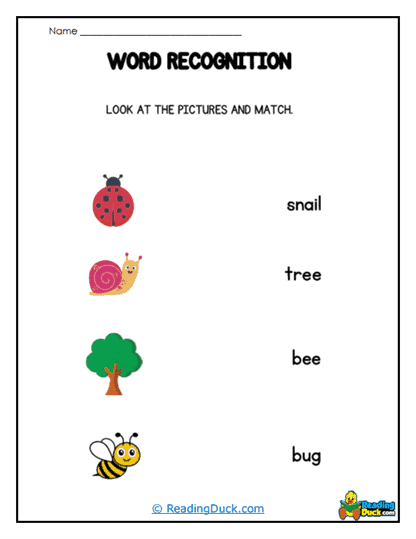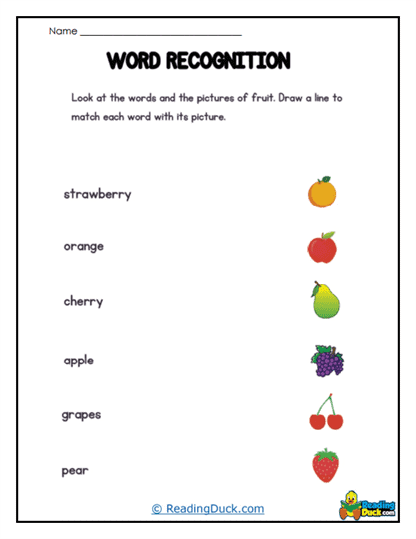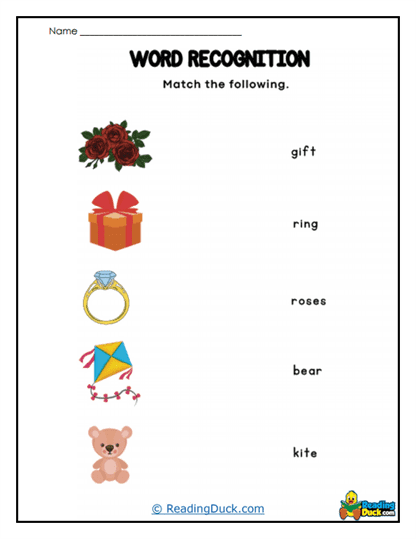Recognizing Words Worksheets
About Our Recognizing Words Worksheets
Our collection of Recognizing Words Worksheets is designed to support young learners in the early stages of reading development. These worksheets are specifically crafted to help students recognize different verbs and vocabulary words, a foundational skill in literacy. By engaging in various activities such as reading and writing words, using them in sentences, visualizing their meanings through drawing, and matching words to pictures, students can build their word recognition skills in a fun and interactive way.
Each worksheet in this collection is available in PDF format, making them easily accessible for electronic viewing, downloading, and printing. This flexibility allows educators and parents to use these resources in both traditional classroom settings and homeschool environments, adapting them to the individual needs of their students.
What is Word Recognition?
Word recognition is a fundamental aspect of early literacy, playing a crucial role in a child's ability to read and comprehend written text. At its core, word recognition involves the ability to identify and understand individual words quickly and accurately. It is the process by which a reader looks at a word and connects it to its meaning without having to stop and decode it each time. This automaticity is essential for fluent reading, as it allows students to focus on the meaning of the text rather than being bogged down by decoding each word.
The Components of Word Recognition
- Phonological Awareness: This is the ability to recognize and manipulate the sounds of spoken language. It includes skills like rhyming, segmenting words into sounds, and blending sounds together. Phonological awareness is the foundation upon which word recognition is built because it helps students understand that words are made up of individual sounds (phonemes).
- Phonics: Phonics involves the relationship between sounds and their corresponding letters or groups of letters. When students understand phonics, they can decode unfamiliar words by sounding them out. However, as they become more familiar with words, they start to recognize them by sight rather than decoding them each time.
- Sight Word Recognition: Sight words are words that students recognize instantly without needing to sound them out. These are often high-frequency words like "the," "and," "is," and "was," which appear frequently in texts. Mastery of sight words is crucial for fluent reading because it reduces the cognitive load on the reader, allowing them to focus on comprehension.
- Contextual Clues: Word recognition is not only about recognizing the word in isolation but also about understanding it within the context of a sentence or story. Students use the surrounding words and the overall meaning of the text to confirm their understanding of a word, which aids in both recognition and comprehension.
- Morphological Awareness: This refers to the understanding of how words are formed by combining prefixes, suffixes, and root words. For example, knowing that the prefix "un-" means "not" helps students recognize and understand words like "unhappy" or "uncertain." Morphological awareness supports word recognition by helping students decode and understand more complex words.
How Does Word Recognition Help Students?
Word recognition is a pivotal skill that significantly impacts a student's overall reading ability and academic success. Here’s how:
- Enhanced Reading Fluency: When students can recognize words quickly and accurately, they read more fluently. Fluency is characterized by smooth, expressive reading with minimal hesitation. Fluent readers are able to focus on the meaning of the text, making reading a more enjoyable and productive experience.
- Improved Vocabulary: As students encounter and recognize more words, they expand their vocabulary. A robust vocabulary is essential not only for reading comprehension but also for effective communication. Students who are adept at word recognition can understand and use a wider range of words in both their oral and written language.
- Stronger Comprehension: Recognizing words effortlessly allows students to focus on understanding the text. When students don't have to struggle with decoding, they can pay more attention to the meaning of the words and sentences, leading to better comprehension. This is particularly important as students encounter more complex texts in higher grades.
- Increased Reading Confidence: As students become more proficient in word recognition, they gain confidence in their reading abilities. This confidence can encourage a more positive attitude toward reading and learning in general. Students who feel successful in reading are more likely to engage with books and other written materials, fostering a love for reading that can last a lifetime.
- Critical Thinking and Problem-Solving: As students learn to recognize words, they also develop critical thinking skills. They learn to use context clues, analyze word structures, and make inferences about meanings. These skills are not only essential for reading but also for problem-solving and analytical thinking in other academic areas.
Key Aspects of Word Recognition:
- Visual Recognition: This involves the ability to identify words by sight, recognizing their patterns, shapes, and structures without needing to sound them out. Visual recognition is particularly important for high-frequency words and irregular words that do not follow typical phonetic rules.
- Contextual Understanding: Recognizing words within the context of a sentence or story helps students understand how words function together to convey meaning. Contextual understanding reinforces word recognition by helping students confirm the meanings of words based on the surrounding text.
- Repetition and Practice: Word recognition is reinforced through frequent exposure and practice. The more often students encounter a word, the more likely they are to recognize it quickly in the future. This is why repeated reading and exposure to words in different contexts are vital components of literacy instruction.
- Application in Sentences: Using recognized words in sentences helps students understand their meanings and how they function grammatically. This application not only reinforces word recognition but also enhances students’ understanding of sentence structure and grammar, which are critical for both reading and writing.
Practical Tips for Using Recognizing Words Worksheets
In the Classroom:
- Morning Work: Use these worksheets as part of a daily morning routine to help students warm up their brains and prepare for the day's lessons. This consistent practice can strengthen their word recognition skills over time.
- Literacy Centers: Incorporate these worksheets into literacy centers, allowing students to work independently or in small groups. This setup encourages collaborative learning and peer support.
- Homework Assignments: Assign these worksheets as homework to reinforce what has been taught in class. This gives students the opportunity to practice word recognition in a quiet, focused environment at home.
- Supplemental Activities: Pair these worksheets with activities like word matching games, flashcards, or digital word recognition apps. These supplementary tools can make learning more engaging and diverse.
In a Homeschool Setup:
- Daily Practice: Integrate these worksheets into your daily homeschool routine, ensuring consistent practice in word recognition, which is crucial for developing strong reading skills.
- Interactive Learning: Combine these worksheets with hands-on activities like drawing, word puzzles, or creating simple stories using recognized words. This approach helps maintain student interest and encourages creative thinking.
- Assessment Tool: Use these worksheets to assess your child's progress in word recognition. Regularly reviewing completed worksheets can help identify areas where more practice is needed.
Grade Levels Benefited:
- Pre-Kindergarten to Kindergarten: These worksheets are ideal for young learners at the beginning of their literacy journey, focusing on basic word recognition and simple vocabulary.
- First Grade: First graders, who are building on their foundational reading skills, can benefit from these worksheets as they begin to recognize more complex words and sentence structures.
- Struggling Readers in Higher Grades: Older students who may need additional support with word recognition can also benefit from these worksheets as a form of targeted practice.
Building Essential Skills Through Word Recognition
Recognizing Words Worksheets are more than just a set of activities; they are a powerful tool for building essential literacy skills that extend beyond reading. By consistently practicing word recognition, students can develop a range of abilities that contribute to their overall academic and personal growth.
Improved Academic Performance:
- Reading Comprehension: As students become more proficient in recognizing words, their ability to comprehend what they read improves. This leads to better performance in subjects that require reading, such as science and social studies.
- Writing Skills: Recognizing words helps students in spelling and writing sentences. With a stronger vocabulary, they can express themselves more clearly and accurately in written form.
- Language Development: Regular exposure to new words and their meanings enhances students' language skills, helping them communicate more effectively in both spoken and written forms.
Personal Development:
- Confidence Building: Mastering word recognition gives students a sense of achievement, boosting their confidence in reading and learning. This self-assurance can lead to a more positive attitude toward school and education.
- Critical Thinking: As students learn to recognize words in different contexts, they develop critical thinking skills by making connections between words, their meanings, and how they are used in language.
- Independence: With strong word recognition skills, students can engage with texts independently, paving the way for lifelong learning and a love of reading.
In conclusion, the Recognizing Words Worksheets collection is an invaluable resource for educators and parents alike, offering structured, engaging practice that supports the development of key literacy skills. By helping students recognize words, we equip them with the tools they need to succeed academically and thrive personally.









